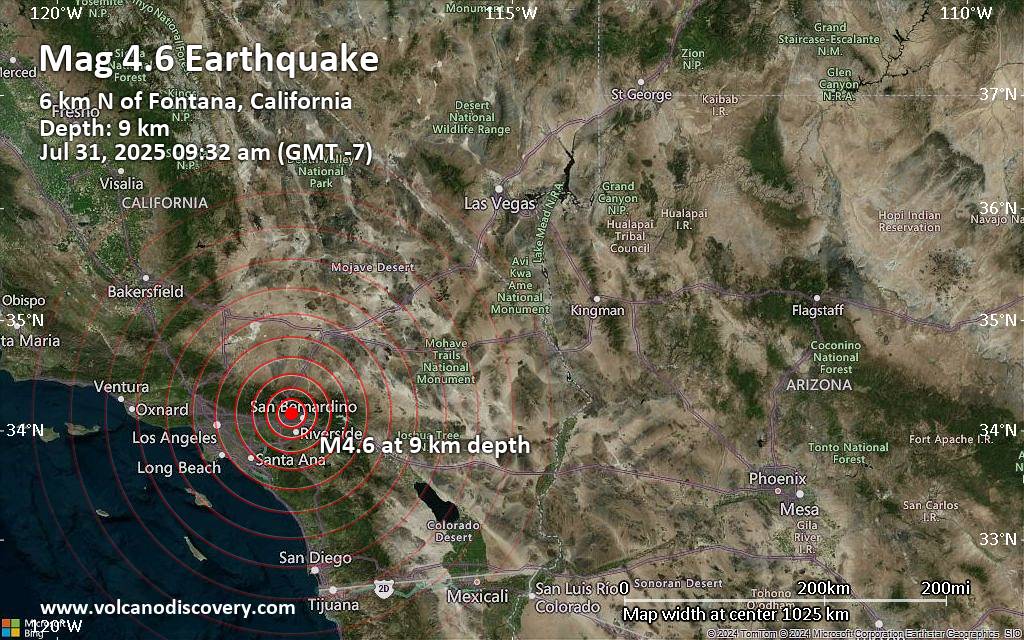At 9:32 a.m. PT on July 31, 2025, a magnitude 4.4 earthquake ruptured near Muscoy, California—just 6 km west of Fontana and 7 km north of Rialto in San Bernardino County. The shallow depth (3.3 miles) amplified shaking across Southern California, with reports from Los Angeles to San Diego and as far east as Ventura.
Three minutes later, a 3.1M aftershock hit Rialto, part of a swarm that included earlier tremors:
- 8:34 a.m.: M3.0 near Rialto
- 8:42 a.m.: M2.8 near Rialto
Residents from high-rises in Irvine to homes in Redondo Beach described a sharp “jolt” or “rolling sensation.” No damage or injuries were reported, but the event underscored the region’s persistent seismic risk.

Why This Fault Matters: The Fontana Seismic Trend
Renowned seismologist Dr. Lucy Jones identified the quake’s origin in the Fontana Trend—a northeast-striking fault system beneath the San Bernardino Valley sediments. This left-lateral fault, south of the San Gabriel Mountains, has hosted multiple swarms historically. Its shallow earthquakes amplify ground shaking, especially in basin areas like San Bernardino and Chino.

Science Spotlight: How Basins Intensify Earthquakes
Recent studies reveal why valleys like San Bernardino and Los Angeles experience stronger shaking:
- Sediment Amplification: Loose soils in basins slow and trap seismic waves, increasing duration.
- 3D Basin Effects: Irregular basin edges (e.g., near the San Jacinto Fault) scatter energy, creating “seismic hotspots.”
The BASIN Project, using 758 seismic sensors, mapped these effects in detail, showing depths up to 4.2 km in the San Gabriel Basin—directly impacting 19.5 million residents.
Los Angeles Earthquake History: Context for Today
| Year | Magnitude | Location | Impact |
|---|---|---|---|
| 2024 | 4.4 | East Los Angeles | Minor shaking |
| 2019 | 7.1 | Ridgecrest | Major damage |
| 1994 | 6.7 | Northridge | 57 fatalities |
| 1952 | 7.5 | Kern County | 12 fatalities |
Southern California averages 24 yearly earthquakes above M4.0. The 2019 Ridgecrest sequence—a M6.4 foreshock and M7.1 mainshock—reminds us that today’s tremors could precede larger events.
Your Earthquake Survival Guide: 7 Critical Steps
- Secure Your Space: Anchor furniture, water heaters, and TVs. Use museum putty for valuables.
- Make a Kit: Include water (1 gal/person/day), non-perishable food, medications, and a flashlight.
- Plan Communications: Designate an out-of-state contact and meetup spots.
- Retrofit Older Homes: Pre-1980 houses likely need foundation bolting. Programs like Earthquake Brace & Bolt offer grants.
- Drop, Cover, Hold On: During shaking, shelter under a table. Avoid doorways!
- Post-Quake Checks: Shut off gas if you smell leaks; text loved ones (don’t call).
- Insure Finances: Standard policies exclude quake damage. Explore CEA coverage.

Why “The Big One” Looms: Science Behind the Risk
Southern California’s seismic threat stems from the Pacific-North American plate boundary, moving 5 cm/year. Key faults include:
- San Andreas: Capable of M8.0+ quakes
- San Jacinto: Most active in San Bernardino Basin
- Cucamonga Fault: Threatens M7.5 events near LA.
A 2023 study warned that basins could prolong “strong shaking” in a mega-quake by 50%, increasing structural damage.
Real-Time Tools Every Angeleno Needs
- MyShake App: Provides seconds-minutes of warning via ShakeAlert.
- USGS “Did You Feel It?”: Report shaking to aid science USGS.
- NotifyLA: Local alerts for evacuations or aftershocks.
Conclusion: Preparedness Is Power
Today’s Fontana-Rialto quakes remind us: earthquakes aren’t if, but when. While a M4.4 causes rattled nerves, it’s a drill for larger events. Secure your space, insure your home, and practice Drop, Cover, Hold On. As Dr. Jones notes, “The Big One will be 44 times stronger than Northridge. Preparation saves lives.”
For ongoing updates, bookmark the USGS Latest Earthquakes page.
“Earthquakes don’t kill people; buildings do.” — Seismologist Dr. Lucy Jones
